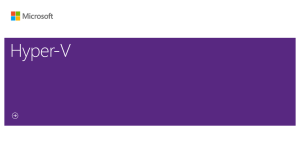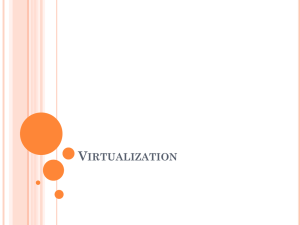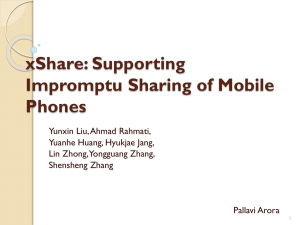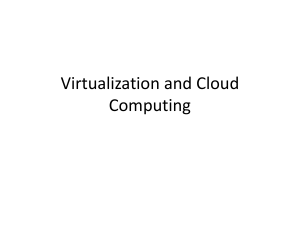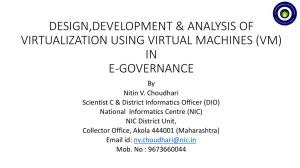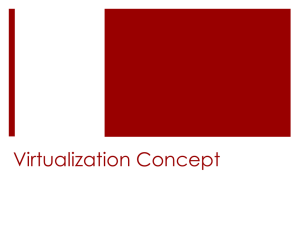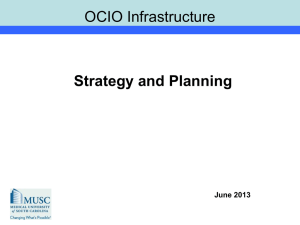Document
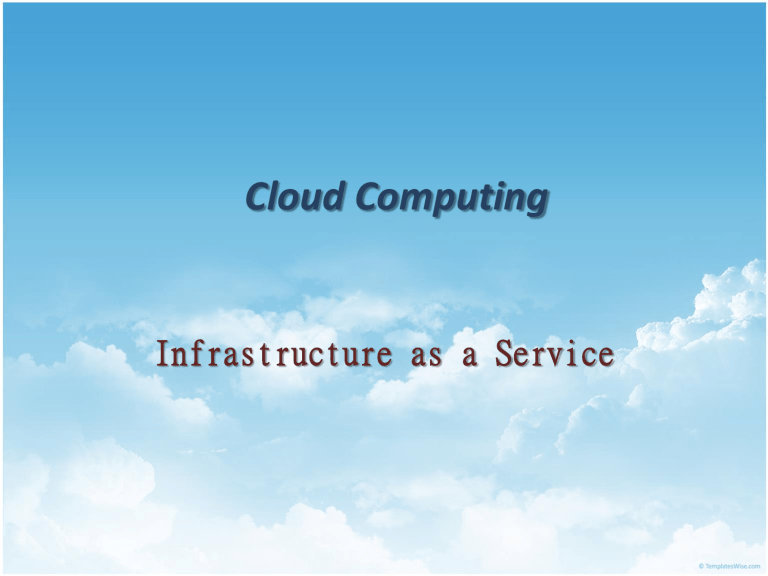
Cloud Computing
Infrastructure as a Service
• Overview
Why do we need IaaS ?
How IaaS meets cloud properties ?
• Enabling Techniques
Virtualization Overview
Terminology & Taxonomy
Agenda
Why do we need IaaS ?
OVERVIEW
Overview
• What is the problems in conventional case ?
Companies IT investment for peak capacity
Lack of agility for IT infrastructure
IT maintain cost for every company
Usually suffered from hardware failure risk
…etc
• These IT complexities force company back !!
Overview
• How to solve these problems ?
Let’s consider some kind of out-sourcing solution
• Somebody will handle on demand capacity for me
• Somebody will handle high available resource for me
• Somebody will handle hardware management for me
• Somebody will handle system performance for me
• Somebody will …
Frankly, that would be a great solution IF there were “somebody”.
But who can be this “somebody”, and provide all these services ?
Overview
• Infrastructure as a Service will be the salvation.
IaaS cloud provider takes care of all the IT infrastructure complexities.
IaaS cloud provider provides all the infrastructure functionalities.
IaaS cloud provider guarantees qualified infrastructure services.
IaaS cloud provider charges clients according to their resource usage.
• But, what make all of these happen so magically ?
Virtualization
• Assume that you are going to be an IaaS cloud provider.
Then, what are the problems you are facing ?
• Clients will request different operating systems.
• Clients will request different storage sizes.
• Clients will request different network bandwidths.
• Clients will change their requests anytime.
• Clients will …
Is there any good strategy ?
• Allocate a new physical machine for each incomer.
• Prepare a pool of pre-installed machines for different requests.
• or …
Virtualization
• What if we allocate a new physical machine for each incomer ?
I want
Windows 7
I want
Linux
Customer A Customer B
I want …
I want …
Virtualization
• How about preparing a pool of pre-installed physical machines for all kinds of request ?
I want
Mac OS
Somebody
Somebody may want might want…
Somebody
Somebody may want might want…
Windows + Office Windows Server Linux + OpenOffice Linux Server
Virtualization
• Obviously, neither of previous strategies will work.
• We need more powerful techniques to deal with that.
• Virtualization techniques will help.
For computation resources
• Virtual Machine technique
For storage resources
• Virtual Storage technique
For communication resources
• Virtual Network technique
Why do we need IaaS ?
How IaaS meets cloud properties ?
OVERVIEW
Properties and Characteristics
• As a cloud provider, all of the fundamental properties and characteristics stated in previous lectures should be concerned and implemented.
Scalability & Elasticity
• What do scalability and elasticity mean in IaaS ?
Clients should be able to dynamically increase or decrease the amount of infrastructure resources in need.
Large amount of resources provisioning and deployment should be done in a short period of time, such as several hours or days.
System behavior should remain identical in small scale or large one.
Scalability & Elasticity
• How to approach scalability and elasticity in IaaS ?
For computation resources :
• Dynamically create or terminate virtual machines for clients on demand.
• Integrate hypervisors among all physical machines to collaboratively control and manage all virtual machines.
For storage resources :
• Dynamically allocate or de-allocate virtual storage space for clients.
• Integrate all physical storage resources in the entire IaaS system
• Offer initial storage resources by thin provisioning technique.
For communication resources :
• Dynamically connect or disconnect the linking state of virtual networks for clients on demand.
• Dynamically divide the network request flow to different physical routers to maintain access bandwidth.
Availability & Reliability
• What do availability and reliability mean in IaaS ?
Clients should be able to access computation resources without considering the possibility of hardware failure.
Data stored in IaaS cloud should be able to be retrieved when needed without considering any natural disaster damage.
Communication capability and capacity should be maintained without considering any physical equipment shortage.
Availability & Reliability
• How to approach availability and reliability in IaaS ?
For computation resources :
• Monitor each physical and virtual machine for any possible failure.
• Regularly backup virtual machine system state for disaster recovery.
• Migrate virtual machine among physical machines for potential failure prevention.
For storage resources :
• Maintain data pieces replication among different physical storage devices.
• Regularly backup virtual storage data to geographical remote locations for disaster prevention.
For communication resources :
• Built redundant connection system to improve robustness.
Manageability & Interoperability
• What do manageability and interoperability mean in IaaS ?
Clients should be able to fully control the virtualized infrastructure resources which allocated to them.
Virtualized resources can be allocated by means of system control automation process with pre-configured policy.
States of all virtualized resource should be fully under monitoring.
Usage of infrastructure resources will be recorded and then billing system will convert these information to user payment.
Manageability & Interoperability
• How to approach manageability and interoperability in IaaS ?
For computation resources :
• Provide basic virtual machine operations, such as creation, termination, suspension, resumption and system snapshot.
• Monitor and record CPU and memory loading for each virtual machine.
For storage resources :
• Monitor and record storage space usage and read/write data access from user for each virtual storage resource.
• Automatic allocate/de-allocate physical storage according to space utilization.
For communication resources :
• Monitor and record the network bandwidth consumption for each virtual link.
• Automatically reroute the data path when computation and storage are duplicated.
Performance & Optimization
• What do performance and optimization mean in IaaS ?
Physical resources should be highly utilized among different clients.
Physical resources should form a large resource pool which provide high computing power through parallel processing.
Virtual infrastructure resources will be dynamically configured to an optimized deployment among physical resources.
Performance & Optimization
• How to approach performance and optimization in IaaS ?
For computation resources :
• Deploy virtual machine with load balancing consideration.
• Live migrate virtual machines among physical ones to balance the system loading.
For storage resources :
• Deploy virtual storage with hot spot access consideration.
• Live migrate virtual storage among physical ones with different performance level.
For communication resources :
• Consider network bandwidth loading when deploying virtual machines and storage.
• Dynamically migrate virtual machines or storage to balance network flow.
Accessibility & Portability
• What do accessibility and portability mean in IaaS ?
Clients should be able to control, manage and access infrastructure resources in an easy way, such as the web-browser, without additional local software or hardware installation.
Provided infrastructure resources should be able to be reallocated or duplicated easily.
Accessibility & Portability
• How to approach accessibility and portability in IaaS ?
For computation resources :
• Cloud provider integrates virtual machine management and access through web-based portal.
• Comply the virtual machine standard for portability.
For storage resources :
• Cloud provider integrates virtual storage management and access through web-based portal.
For communication resources :
• Cloud provider integrates virtual network management and access through web-based portal.
Virtualization
ENABLING TECHNIQUES
IaaS Architecture
• Infrastructure as a Service (IaaS) delivers computer infrastructure for cloud user, typically a platform virtualization environment as a service.
• Virtualization is an enabling technique to provide an abstraction of logical resources away from underlying physical resources.
Virtualization Overview
• What is virtualization ?
Virtualization is the creation of a virtual (rather than physical) version of something, such as an operating system, a server, a storage device or network resources.
It hides the physical characteristics of a resource from users, instead showing another abstract resource.
• But, where does virtualization come from ?
Virtualization is NOT a new idea of computer science.
Virtualization concept comes from the component abstraction of system design, and it has been adapted at many system levels.
Now, let’s take a look of our original system architecture !!
Virtualization Overview
• System abstraction :
Computer systems are built on levels of abstraction.
Higher level of abstraction hide details at lower levels.
Designer of each abstraction level make use of the functions supported from its lower level, and provide another abstraction to its higher one.
Example
• files are an abstraction of a disk
Virtualization Overview
• Machine level abstraction :
For OS developers, a machine is defined by ISA (Instruction
Set Architecture).
This is the major division between hardware and software.
Examples :
• X86
• ARM
• MIPS
Virtualization Overview
• OS level abstraction :
For compiler or library developers, a machine is defined by ABI (Application
Binary Interface).
This define the basic OS interface which may be used by libraries or user.
Examples :
• User ISA
• OS system call
Virtualization Overview
• Library level abstraction :
For application developers, a machine is defined by API
(Application Programming
Interface).
This abstraction provides the well-rounded functionalities.
Examples :
• User ISA
• Standard C library
• Graphical library
Virtualization Overview
• The concept of virtualization is everywhere !!
In IaaS, we focus the virtualization granularity at each physical hardware device.
• General virtualization implementation level :
Virtualized instance
• Software virtualized hardware instance
Virtualization layer
• Software virtualization implementation
Abstraction layer
• Various types of hardware access interface
Physical hardware
• Various types of infrastructure resources
• Different physical resources :
Server, Storage and Network
Terminology & Taxonomy
VIRTUALIZATION
Virtual Machine
• What is Virtual Machine (VM)?
VM is a software implementation of a machine (i.e. a computer) that executes programs like a real machine.
• Terminology :
Host (Target)
• The primary environment where will be the target of virtualization.
Guest (Source)
• The virtualized environment where will be the source of virtualization.
Emulation vs. Virtualization
• Emulation technique
Simulate an independent environment where guest ISA and host ISA are different.
Example
• Emulate x86 architecture on ARM platform.
• Virtualization technique
Simulate an independent environment where guest ISA and host ISA are the same.
Example
• Virtualize x86 architecture to multiple instances.
Process Virtual Machine
• Process virtual machine
Usually execute guest applications with an ISA different from host
Couple at ABI (Application Binary Interface) level via runtime system
Not persistent
System Virtual Machine
• System virtual machine
Provide the entire operating system on same or different host ISA
Constructed at ISA level
Persistent
Virtual Machine Monitor
• What’s Virtual Machine Monitor (VMM) ?
VMM or Hypervisor is the software layer providing the virtualization.
• System architecture :
VM1 VM2 VM3
Virtualization Types
• Virtualization Types :
Type 1 – Bare metal
• VMMs run directly on the host's hardware as a hardware control and guest operating system monitor.
Type 2 – Hosted
• VMMs are software applications running within a conventional operating system.
37
Virtualization Approaches
• Virtualization Approaches :
Full-Virtualization
• VMM simulates enough hardware to allow an unmodified guest OS.
Para-Virtualization
• VMM does not necessarily simulate hardware, but instead offers a special
API that can only be used by the modified guest OS.
38
Virtualization Approaches
• Full-Virtualization
Pros
Cons
Need not to modify guest OS
Significant performance hit
39
Virtualization Approaches
• Para-Virtualization
Pros
Cons
Light weight and high performance
Require modification of guest OS
40
Xen
• Type 1 Virtualization
• Para-Virtualization
Examples
KVM
• Type 2 Virtualization
• Full-Virtualization
41
• Virtualization techniques
To be continued…
Server Virtualization Storage Virtualization Network Virtualization
References
• James Smith and Ravi Nair, “Virtual Machines: Versatile
Platforms for Systems and Processors”.
• Xen. http://www.xen.org/
• Kernel-based Virtual Machine (KVM). http://www.linuxkvm.org/page/Main_Page
• From Wikipedia, the free encyclopedia
• All resources of the materials and pictures were partially retrieved from the Internet.


